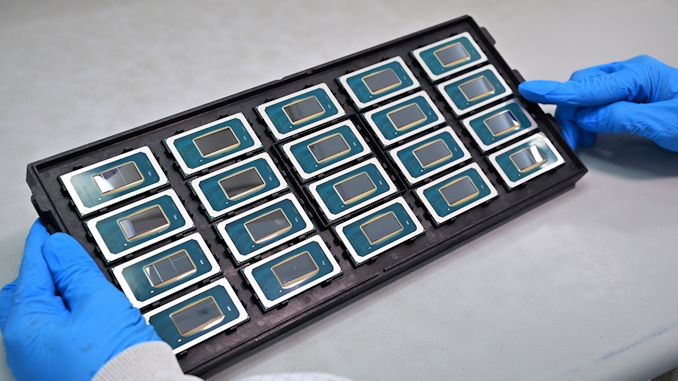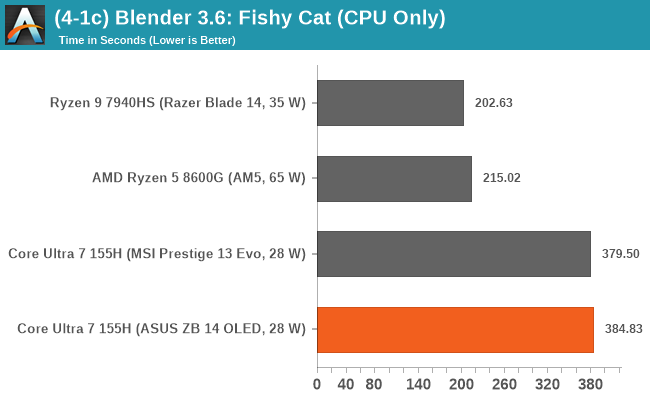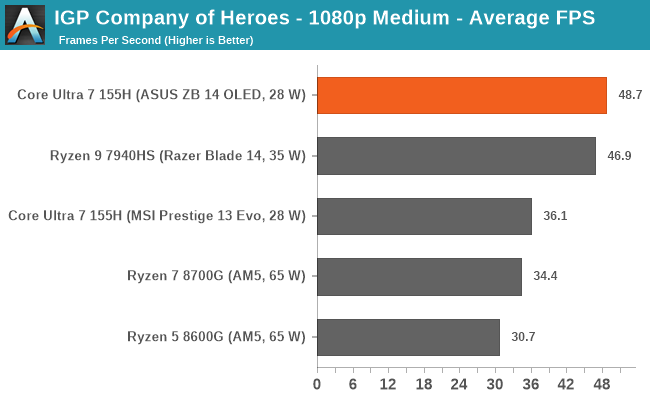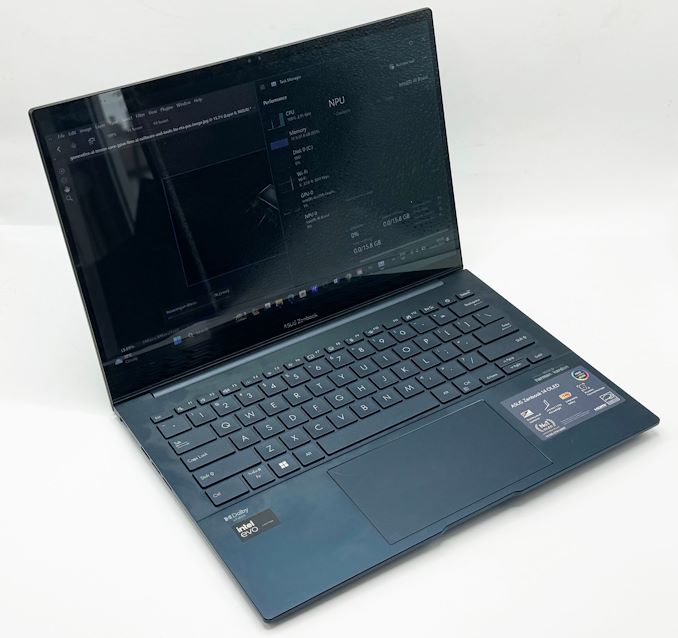The Intel Core Ultra 7 155H Review: Meteor Lake Marks A Fresh Start To Mobile CPUs
by Gavin Bonshor on April 11, 2024 8:30 AM ESTConclusion
Perhaps the biggest buzzword in technology right now is AI, and the industry is hard at work to keep up with the demand and find new and more effective use cases to capitalize on it. Last year, Intel unveiled their Meteor Lake SoC architecture, which not only brings an entirely new tiled architecture design to its mobile portfolio but also drives much of Intel's marketing and focus, which includes the Neural Processing Unit (NPU) found within the SoC tile. While the Intel AI Boost NPU and AMD's equivalent Ryzen AI aren't as complex or transformative to all areas of AI performance, there are specific low-impact use cases where chip vendors expect these processing blocks to be utilized.
That being said, the Intel Core Ultra line is much more than just its NPU. Meteor Lake represents a paradigm shift in how CPUs are assembled in the realm of mobile computing, with the combination of four primary tiles fabbed on different manufacturing processes, all rolled into one SoC for notebook vendors to use. These include the SoC tile, which houses the Intel AI Boost NPU, two low power-island (LP) CPU cores, and a new graphics tile, which includes Intel's Arc-based Xe LPG integrated graphics. Also new to the table and building on the heterogeneous nature of using performance (P) and efficiency (E) cores is the compute tile, built on Intel's latest process and brings the Intel 4 into the mix.

A tray of Intel Meteor Lake processors (credit: Intel)
Core Ultra 7 155H Performance Summary
In this review, we've tested Intel's Meteor Lake SoC, the Intel Core Ultra 7 155H, in two forms: ASUS's Zenbook 14 OLED UX3405 ultrabook, which was Intel's official sample hardware for this launch, as well as MSI's Prestige 13 Evo A1MG, a slightly smaller and compact ultrabook. While both devices are similar in configuration, this gives us a second look a Core Ultra's performance, to make sure what we're seeing with the ASUS laptop is similar to what's going on other devices.
For our comparative analysis, we've put the Core Ultra 155H up against AMD's Ryzen 9 7940HS, which is an 8C/16T SKU based on AMD's Phoenix die. Fabbed on TSMC's 4nm node and built from AMD's Zen 4 CPU cores, it provides a good level of competition – though it does get a significant advantage in our tests from the much higher 42 Watt TDP afforded by the Razer laptop it's in. To make things a bit closer to apples-to-apples, we dialed down the Ryzen 9 7940HS to the base TDP of 35 Watts, as it was drawing more power which did give it a distinct advantage in multi-threaded applications. We've also tossed in AMD's Phoenix die in desktop form with the Ryzen 5 8600G, to provide a baseline for how these mobile chips compare to a basic desktop CPU.

The Intel Core Ultra 7 155H, when considering all areas of performance, is generally a mixed bag. In some areas, Intel's Meteor Lake SoC shines and is competitive; others don't quite make the big splash that Intel wanted. In cases where Meteor Lake doesn't provide much competition, they are in intensive multi-threaded workloads, such as Blender. As we can see above, the Core Ultra 7 155H is below the capabilities of AMD's Ryzen 9 7940HS, even when we've power-limited it to between 35 W and 39 W. We know Zen 4 is a highly efficient architecture when dropping power, as seen from our numerous reviews of AMD's Ryzen 7000 series.

Moving to simulation, things are much more competitive, with the Intel Core Ultra 7 155H actually sitting above not only the Ryzen 9 7940HS but also the adapted Ryzen 5 8600G APU. All three use the same AMD Phoenix-based silicon. Results vary depending on the type of simulation, but it's good to see use cases where Intel's Meteor Lake chip shines.

One of the key areas where Intel is advertising Meteor Lake to shine is in AI. However, many current AI inferencing workloads don't use (or, at least, strongly benefit from) dedicated NPUs, such as Intel's AI Boost NPU, and fewer still can use AMD's Ryzen AI engine. None the less, both hardware vendors and software vendors are making significant investments in the ecosystem around NPUs, both to provide more powerful hardware and software to make use of them. So the importance of NPUs will only grow from here as the PC industry looks to push their AI PC branding initiative.
At a high level, NPUs are intended to offer better power efficiencies and higher overall performance than GPUs and CPUs when it comes to the dense matrix math at the core of many modern AI models. Putting Meteor Lake's NPU to the test through UL's updated Procyon Computer Vision AI benchmark, we can see that in this particular benchmark with OpenVino and the ResNet 50 model using an integer floating point, the NPU within the Core Ultra 7 155H performed very well, with the Arc Xe integrated graphics coming in around 31% behind when counting the total number of inferences.
Intel AI Boost (NPU) within Meteor Lake aims to improve efficiency by offloading inferencing workloads from the CPU and GPU directly onto the NPU. While it's not a one-size-fits-all approach, as currently, Intel's NPU can't be utilized by a vast array of workloads and situations yet, there's certainly some benefit to be had by implementing the NPU. As we can see by using the UL Procyon AI Computer Vision benchmark with the OpenVino option enabling each of the core components to be tested (NPU, CPU, GPU), we can see that offloading onto the NPU offers a massive power saving of around between 10-12 W over using the CPU on its own.
Even compared to the GPU, the NPU is again more power efficient, saving around 3-4 W on average while delivering 46% higher performance in this benchmark. The biggest gain is clearly offloading from the CPU to the NPU, which over a prolonged period of time will certainly save battery life. Still, depending on what else is happening in the background, it could be a case of multiple elements being utilized by different programs and background tasks.

Focusing on gaming performance when comparing Intel's latest Arc Xe LPG mobile integrated graphics directly to AMD's preexisting Radeon 780M and 760M, things generally come down to what title is being played. Intel wins out in Returnal, which does seem to favor Intel chips from what we've seen so far, although things are very competitive at 1080p Medium settings in Company of Heroes 3, as seen above. The ASUS Zenbook 14 OLED performs better than the MSI Prestige 13 Evo in most games we tested, although it is a smaller ultrabook and operates with a lower overall power envelope. Still, performance is decent and very competitive when things rely more on the Arc Xe LPG graphics cores than the CPU, as we saw in Total War Warhammer 3, where 5% lows were not up to the required standard expected.
ASUS Zenbook 14 OLED UX3405: A Solid Representation of a Core Ultra Ultraportable
Before we wrap things up, we must pay credence to the ASUS Zenbook 14 OLED UX3405 ultrabook. It isn't only the delivery platform for Meteor Lake that we've been testing. Still, the Zenbook 14 OLED has plenty to offer for users on the go who are looking for an ultraportable notebook with a slim yet exquisite and stylish chassis.
Overall, the UX3405, it looks very similar to its predecessors in design. Still, it harnesses plenty of capability through the specifications, including but not limited to Intel's latest Core Ultra 7 155H 22-core (6P+8E+2LP) mobile processor/SoC. Also included is 32 GB of LPDDR5X memory, which at least for one more generation of products, remains soldered into the mainboard. This leaves storage as the only end-user upgradeable option, although the included 1 TB PCIe 4.0 x2 M.2 NVMe drive is already plenty adequate for a laptop such as this.
Other ASUS Zenbook 14 OLED UX3405 features include Intel's AX211 Wi-Fi 6E wireless interface, which supports the latest Bluetooth 5.3 devices. There are also dual Thunderbolt 4-capable USB Type-C ports, which support charging and external displays – and indeed, USB-C charging is the only charging offered on this laptop. Much of the focus with this laptop surrounds the 14-inch 2880 x 1800 touchscreen and all the vibrancy expected from an OLED panel. It also offers a variable refresh rate, where users can select between 60 Hz or reap the benefits of a faster 120 Hz panel. However, unlike on gaming laptops, this is primarily for smoother video playback and isn't designed as a gaming feature.
Final Thoughts: Meteor Lake Core Ultra 7 155H Trades-off Performance For Efficiency
Wrapping up our review of the Intel Core Ultra 7 155H, Intel has set about creating a chip that, unlike its last couple of generations of hardware, has a true mobile-first focus. To be sure, Core Ultra packs no shortage of performance, but everything from the focus on efficiency to the inclusion of an NPU, and I/O features like Thunderbolt 4 make this scream a laptop chip. Which, with laptops being the bulk of the PC market these days, is where all the action is from a volume standpoint.
From the perspective of the ASUS Zenbook 14 OLED UX3405MA, it's particularly commendable, with things such as the sound quality of the Harmon Kardon speakers and the vibrancy of the 14-inch OLED panel delivering a good user experience combined with the Core Ultra 7 155H. That being said, having such a lightweight and thin chassis poses trade-offs that cannot be ignored, in that it somewhat limits the full performance of Intel's Core Ultra 7 155 Meteor Lake SoC. This is after all an H-class chip, which goes in to everything upwards of 16-inch workstation laptops, so it doesn't get to fully stretch its legs in a 28 Watt ultraportable chassis. Thankfully, even when Core Ultra doesn't get to stretch its legs in terms of performance, it does get to do so in terms of energy efficiency and battery life, and the ASUS unit certainly delivered in this particular area, with runtimes in productivity workloads easily exceeding 12 hours.

The ASUS Zenbook 14 OLED UX3405MA is just 14.9 mm thick
In summary, the Intel Core 7 Ultra 155H makes a strong case as a versatile mobile processor with decent levels of compute performance, some really advantageous AI inferencing efficiency in situations where AI workloads can be offloaded onto the NPU, and solid mobile gaming performance due to the inclusion of Intel's Arc Xe LPG integrated graphics. Like in many situations, results may vary depending on the workload and the task, and for those with a high reliance on single-threaded performance and short workloads, the Core Ultra 7 155H performance is great. On the multi-thread side, power becomes a big factor, and at least in a 28 Watt chassis, there's not enough headroom to let all 16 of those CPU cores reach their full potential.
On the graphics front, the Intel Core Ultra's integrated Arc Xe LPG graphics positions it as a formidable contender in a highly competitive market, especially compared to AMD's rival, the Radeon 780M. While the rest of the Core Ultra 7 155H adeptly handles a range of tasks, from everyday productivity to more demanding applications, the levels of performance on offer may not satisfy the demand from some users who are used to more powerful chips.
Better power efficiency usually means longer battery life, and this is a trade-off potential buyers must decide for themselves. Finding the middle ground between the two ideals of performance and power efficiency is a priority for most chip makers. Meteor Lake does a good job at landing between both metrics, but Intel leans more toward the efficiency side than raw throughput performance.
Ultimately, if we're being pragmatic in our evaluation, the Intel Core Ultra 7 155H isn't going to win any awards for performance or deliver the levels of performance that make most users drop their jaws in awe, but that's not what Meteor Lake is all about. Instead, Meteor Lake is about delivering a high efficiency chip to better compete with the AMDs, Apples, and soon-to-be-Qualcomms of the world, all the while validating Intel's first serious disaggregated architecture (sorry, Lakeview). In terms of efficiency and the performance of the Arc Xe LPG iGPU, it's a very good win for Intel, but perhaps users looking for a bit more compute grunt may need to look elsewhere.
Think of Meteor Lake as the stepping stone for Intel's client computing portfolio, upon which the tiled architecture can be built, as well as improving on things such as scalability and node flexibility within the full package of tiles implemented. As we expect more details to come out later this year about Arrow Lake and Lunar Lake, Meteor Lake does a good job overall in planting the seed of how well a mobile tiled architecture can pave the way for the next generation of tiled client processors, especially as Intel moves ahead on their '5 nodes in 4 years' commitment, with Intel 3 already in manufacturing and Intel 20A looking set to come online this year.












69 Comments
View All Comments
jeenam - Friday, April 12, 2024 - link
I've been an anandtech reader since 1998 or so and I'm not here to pick a bone. I'm a fan, and hope AT lives on. But did a quick search and the only two major websites with GPU reviews that referenced Returnal or Company of Heroes were Hot Hardware and Ars Technica. An expanded test suite of games might have been more appropriate because it's likely the ARC GPU would have been handily beaten across the board. Replysjkpublic@gmail.com - Thursday, April 11, 2024 - link
Strange. Some of the tests list the 155H as 28W with test results. This is misleading as the SoC uses much more power doing the test. ReplyGavin Bonshor - Friday, April 12, 2024 - link
When we review CPUs, especially when highlighting them in the charts, we list the base TDP, as every motherboard has its own interpretation of what level of power it will push through the chip (Multi-core enhancement). ReplyCarmen00 - Friday, April 12, 2024 - link
Yet in another comment, we have Ryan Smith saying "With these integrated devices, we're reviewing the notebook as much as we're reviewing the chip inside."So if you're doing what he says—post the right numbers, because that's what you're doing. And if you're NOT doing what he says, then don't post useless stuff that seems, to my (perhaps overly-critical eye) to exist so that the article can claim that Intel is scoring SOME kind of a win, when the graphs really don't seem to show a heck of a lot of CPU-related win.
I'm fine with either, let me be honest. But I want to see some consistency, that is all. Reply
Ryan Smith - Friday, April 12, 2024 - link
I'm all for trying to make sure you guys get the data that you want to see. But not sure I follow here. We are being consistent in our testing methodology, and taking care to be explicit in that our test systems don't have identical TDPs.https://images.anandtech.com/doci/21282/Core%20Ult...
In a laptop, sustained TDPs are our primary concern, as these devices cannot turbo multiple cores for more than a few seconds. So this is what we're noting in an article like this, to illustrate how we aren't testing devices with matching TDPs. Reply
ballsystemlord - Friday, April 12, 2024 - link
I agree with Ryan here, sustained performance is what you should be looking at. Anything can turbo to infinity.The only real use case for turbo, would be application start-up. But even then, you'd have to be waking the PC from idle and selecting the application in record time for it to matter at all. Reply
lmcd - Wednesday, April 17, 2024 - link
The problem I'm seeing is that this article takes the format of previous laptop reviews but not the depth (in part due to the declining access this publication), and the headline could better fit the contents. It could even be something silly like "The Intel Core Ultra 7 155H Review: Meteor Lake starts with a Moment of Zen(Book)" and be more valuable to the reader.It also did not feel like we really got (even a rehash of) an overview of Meteor Lake as a platform. So to me, this was an ASUS Zenbook review. Framing this as "ASUS ZenBook 14 OLED: A Meteor Lake Thin&Light Review" also better captures its content. Reply
eastcoast_pete - Friday, April 12, 2024 - link
I am not surprised that the Core 7 Meteor Lake isn't beating the Ryzen 7840HS in compute or graphics - that particular Ryzen 4 monolith is (IMHO) currently AMD's best foot forward, and a great APU. However, Intel did do its homework when it comes to the intended use of Meteor Lake SoCs: mobile, especially light and ultralight laptops and 2-in-1s. I don't expect a ~ 1 kg notebook to do that much higher level gaming or compute. I do expect long runtime on battery, fluid use of office and other productivity apps, and otherwise decent performance (speed). Again, AMD's Phoenix/Hawk APUs are, right now, the most performant solutions in that class, but it's good news for all of us that Intel has closed the gap. It'll mean that AMD will have to keep evolving its APUs, and maybe do a better job making them broadly available with good drivers within a few months of announcing them. Because that was not the case with Phoenix, which just took too long to be ready for prime time, and left the opening for Intel to move back into.Lastly, I find that one of the most remarkable things about Meteor Lake is that Intel got its tile design and packaging working quite well. Being able to combine different chips from different fabs (Intel and TSMC) and nodes into a cohesive unit without incurring large hits on performance and efficiency is big step forward. Reply
nandnandnand - Saturday, April 13, 2024 - link
Lunar Lake will be the one to watch. It's Meteor Lake-U evolved (4+4 instead of 2+8, on-package memory by default, decent graphics). Low power mobile chips are more interesting than the 45W+ ones. Replymode_13h - Monday, April 15, 2024 - link
> Being able to combine different chips from different fabs (Intel and TSMC)> and nodes into a cohesive unit without incurring large hits on performance
> and efficiency is big step forward.
AMD combined chiplets from both TSMC and Global Foundries in the same CPU, all the way back in Zen 2! If you count HBM, they combined chiplets from different foundries as far back as their HD Fury GPUs.
As for performance and efficiency, I find Meteor Lake underwhelming on both fronts. Idle performance and things like video playback gain a benefit from the new SoC architecture, but when it comes to compute-intensive tasks, we see why Intel kept around Raptor Lake for the performance-oriented segment. Reply